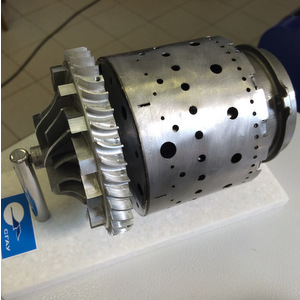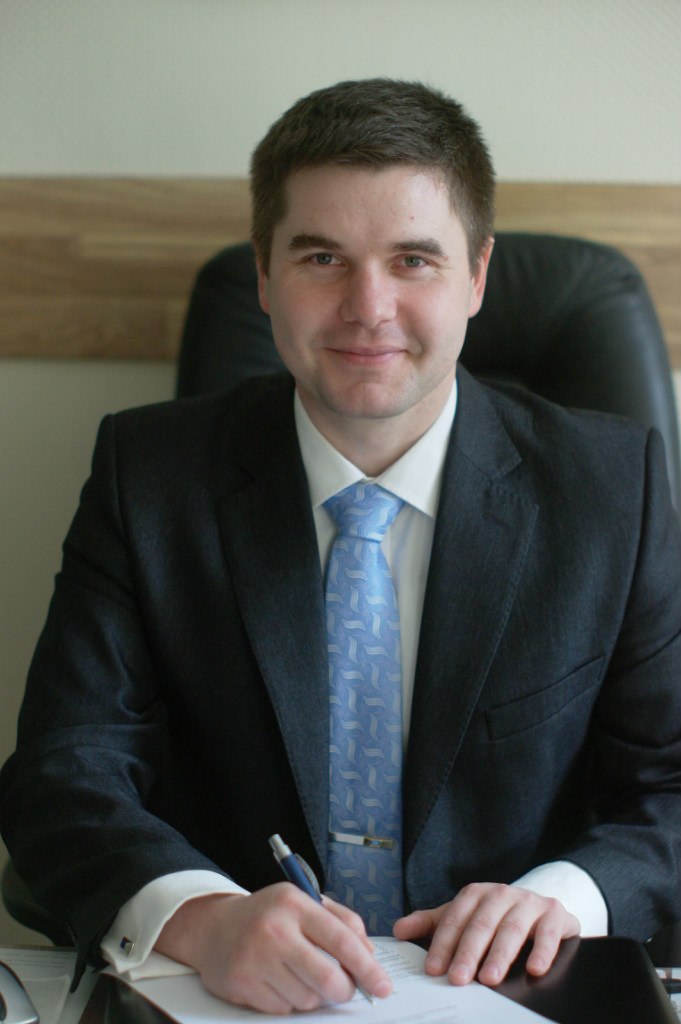
English > News
Innovative breakthrough - SSAU additive technologies become reality
06.08.2015, 17:20
The first details for the small-sized gas turbine engine were made on the selective laser sintering installation in SSAU. The combustion chamber and the turbine, “grown” on the printer, were sent for bench testing to determine the performance specifications of the products.
Vitaliy Smelov, associate professor of the Department of Engine Manufacturing Technology, Head of the Laboratory of Additive Technologies in SSAU, told the conducted work, the prospects for the innovation use in production as well as the difference between the metal printing and the traditional technology.
 - Additive technologies today are the most dynamically developing sector of innovative production, a kind of indicator of the real industrial development of the government. Currently there is a gradual implementation of additive machines resources into production in Russia, but at first it’s necessary to perform experimental confirmation of these resources, first of all for the organization of a real high-tech production. The interest in AM technology (Additive Manufacturing) is not accidental: it’s possible to produce tools, industrial equipment, and parts of engines, satellites, missiles and a lot of other things with the help of material sintering. In addition, a direct product “growing” on a metal printer is economically viable alternative to conventional production methods in the field of aviation, space industry and power engineering. It is strategically important and priority area of research in our laboratory and SSAU. It stands to reason that the first details are within the scope of engine technology.
- Additive technologies today are the most dynamically developing sector of innovative production, a kind of indicator of the real industrial development of the government. Currently there is a gradual implementation of additive machines resources into production in Russia, but at first it’s necessary to perform experimental confirmation of these resources, first of all for the organization of a real high-tech production. The interest in AM technology (Additive Manufacturing) is not accidental: it’s possible to produce tools, industrial equipment, and parts of engines, satellites, missiles and a lot of other things with the help of material sintering. In addition, a direct product “growing” on a metal printer is economically viable alternative to conventional production methods in the field of aviation, space industry and power engineering. It is strategically important and priority area of research in our laboratory and SSAU. It stands to reason that the first details are within the scope of engine technology.- Vitaliy Gennadievich, how did the work of details production take place?
- As a basis, we have taken the scheme and 3D-models of the parts for a small-sized engine developed at the Faculty of Flight Type Engines. The most important parts - the combustion chamber and the turbine were selected for the initial tests. Fusion modes and support types have been set using the software. It took about 10 hours to produce each part. The combustion chamber and the turbine are made of metal, and after bench test it will be possible to use them in a real engine. It should be mentioned at once, that for now our “grown” parts are just samples, which are required to correct the engine design for obtaining more accurate operating parameters.
- What is the difference between the additive and traditional technologies?
- Earlier conventional technology used at the enterprises to make a part, for which the equipment was required. That has always been associated with additional time-consuming. This production cycle could reach three to six months. Today, with additive production it takes about 48 hours.
New technologies make it possible to use almost exactly the amount of material (metal powder), which is necessary for the finished part. It also reduces the time for the part and the engine model prototyping. In conjunction, this provides a tangible economic effect: labour costs in the production of high-tech products, material volume and processing time are reduced.
And one more important difference is the ability to perform a quick change of the products shape and to get accelerated receipt of parts. After all, modern production is characterized by a relatively fast change of products. In such case the basic components that determine the functional quality of the product often do not change, only the design itself - the housing elements, decorative elements, and so on. For this reason, in some cases there is no need in the expensive equipment. Through AM-technologies it’s possible to make a matrix or a compression mould from a light metal alloy with fewer resources. The compression mould can be made with the cooling lines of optional configurations, which cannot be done with conventional machining methods.
- Are the “grown” parts inferior to the usual parts in the metal composition and quality characteristics?
- The metal powders having the same chemical composition as the blank for traditional processing methods are used in our parts. However, the strength properties results obtained on the samples are comparable with the blanks obtained by moulding and are inferior to the formed ones so far. There is another problem - production of domestic metal powders. Currently, in Russia domestic powder materials for selective laser melting installations are being developed in Federal State Unitary Enterprise “VIAM” and they are not inferior in quality to the foreign analogues. In particular, the domestic production already uses Russian metal powders from heat-resistant nickel-based alloy.
- But there are higher requirements for aerospace industry products, isn’t it?
- Certainly, aerospace engineering products are high load items; they are complicated both in a constructive and in technological performance. The conditions under which the details work are rather hard; therefore the quality requirements for manufacture of such products are high. It is worth noting that researchers conducted on the samples obtained on our 3D machine, fully meet the requirements for the aerospace engineering products. The grown samples have shown good results in high thermal load, and also positive results were obtained in the strength tests. All this testify that the quality of the obtained product is high enough, and it will find the application in the aerospace industry by no doubt.
- What kind of promising areas in the field of additive technologies are being developed today in SSAU?
- The main areas include development and research of the process of selective laser sintering products from the composite materials as well as development of 3D installation allowing to make figurine-shaped complex elements of aircraft engines by direct laser growth. The problem solution will enable in a short time to get physical prototypes of new equipment and develop serial production. It is especially topical in view of the strategy of import substitution and import advance in high-tech industries. This directly relates to the gas turbine engine-building. So, as part of the Federal Target Program “Research and Development on Priority Directions of Scientific and Technological Complex of Russia for 2014 – 2020”, we act as joint contractors in the development of the first domestic high-productive 3-D printer for metal printing. All developments are carried out in conjunction with the St. Petersburg Polytechnic University. JSC “Kuznetsov” will become the first user of the new printer, for which it’s necessary to make an installation sample within the framework of this project in 2017.
Interviewed by Dmitriy Popov










